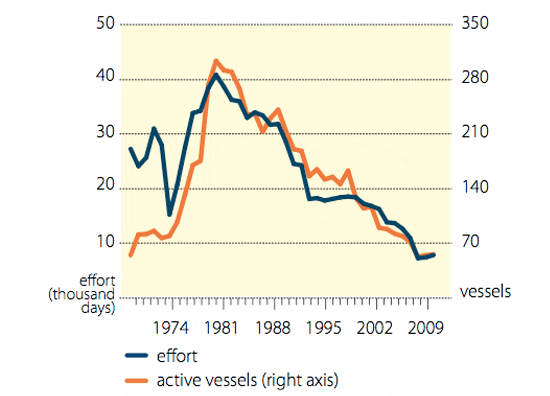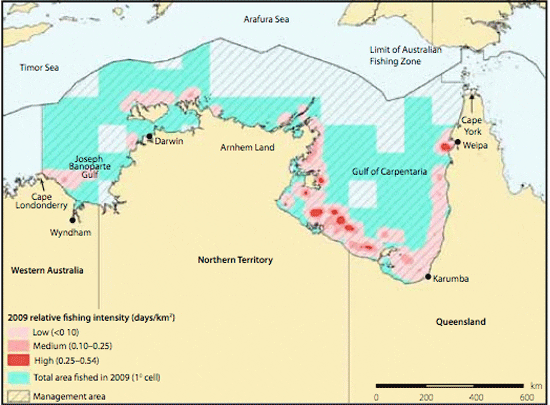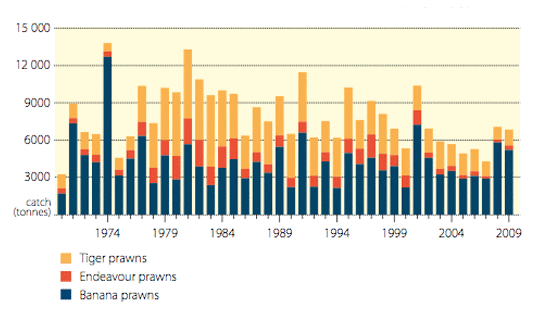Overview of the fishery
The Northern Prawn Fishery (NPF) is located off Australia’s northern coast, between Cape York, Queensland and Cape Londonderry, Western Australia (map 2).
It is a multi-species fishery that targets prawns using otter trawls. The major ports for the NPF are Darwin and Karumba, but much of the catch is offloaded to ‘mother ships’ (vessels that supply fuel and food and transport catch to ports) at sea. In 2008–09, the gross value of production of the NPF was $74 million (Larcombe et al. 2010), making it the most valuable Commonwealth fishery.
There were 52 active vessels in 2009, which caught a total of 6853 tonnes (figures 3 and 4). The target species for the NPF are the red-legged banana prawn, white banana prawn, brown tiger prawn and grooved tiger prawn. The blue endeavour prawn, red endeavour prawn, red-spot king prawn, western king prawn, bugs, various finfish, scampi, scallops and squid are important by-product species.
In the NPF, white banana prawns and the two tiger prawns (brown and grooved) account for approximately 80 per cent of the landed catch (figure 4). There are two separate fishing seasons—a short banana prawn season which commences around April and lasts 6–10 weeks and a longer tiger prawn fishing season commencing in August–September for 10–12 weeks. Catches of banana prawns have been highly variable in the history of the fishery, ranging from approximately 2000 to 7000 tonnes, with a peak of over 12 000 tonnes in 1974 and a long term average of approximately 4300 tonnes (figure 4).
Catches of tiger prawns have decreased in recent years, in part because of stock declines and subsequent reductions in effort to promote the recovery of stocks (figures 3 and 4).
Figure 3: Estimates of effort and number of active vessels for the Northern Prawn Fishery, 1970–2009

Effort in the NPF, in terms of fishing days, has declined since the mid-1980s (figure 3). In response to declining tiger prawn stocks, a buyback scheme occurred between 1987 and 1993 to reduce the number of licences in the fishery. Another structural adjustment package in 2006 (the Securing Our Fishing Future package) removed a further 45 per cent of boat Statutory Fishing Rights and 34 per cent of gear Statutory Fishing Rights (Larcombe and McLoughlin 2007).
There are currently 52 Statutory Fishing Rights in the fishery. Tiger prawn stocks have since recovered, with both tiger and banana prawn species listed as not overfished and not subject to overfishing (Larcombe et al. 2010). The stock status for both endeavour and king prawn species is uncertain. The NPF is expecting to move from input controls to individual transferable quotas in 2011.
Management area and the 2009 relative fishing intensity in the Northern Prawn Fishery

Figure 4: Catch estimates for banana prawns, endeavour prawns and tiger prawns in the Northern Prawn Fishery, 1970–2009

There is no recreational fishery for the key species in the area of the NPF, except for white banana prawns in the Darwin area, generally from February to March (Kailola et al. 1993).
Potential effects of climate change on target species
Rainfall and sea level rise have been identified by Hobday et al. (2008) as key impacts of climate change in the NPF region. In some regions of the banana prawn fishery, there is a strong positive relationship between catches of banana prawn and rainfall (Hobday et al. 2008).
The highest catches of banana prawns in the NPF have usually followed summers with higher than average rainfall (Staples and Vance 1986). Rainfall is highly seasonal in the Gulf of Carpentaria, where most rainfall (approximately 84 per cent) occurs between November and March (Vance et al. 1998). The banana prawn fishing season opens soon after March and most prawns are caught in April. Rainfall is important to banana prawns as it is thought to stimulate the emigration of juvenile prawns from their estuarine mangrove habitats (Vance et al. 1998).
This may be directly through flushing or indirectly through factors associated with heavy rainfall such as disturbance to sediments and lower salinity. Climate change projections for rainfall are highly uncertain; rainfall is projected to decrease across parts of northern Australia with some areas showing a slight increase which may have a positive impact on banana prawn catches (Hobday et al. 2008).
Climate change may also have an impact on seagrass beds and mangrove forests, which are important nursery grounds for tiger prawns and banana prawns, respectively. There are permanent and seasonal area closures in the fishery to help protect nursery areas. The distribution of seagrass beds could be affected by a rise in sea level for a number of reasons, the greatest being an increase in water depth and consequent reduction in available light to the bottom (Short and Neckles 1999).
This could result in reduced distribution and productivity. A 50 cm increase in water depth due to sea level rise could reduce available light by 50 per cent, which in turn could cause a 30 to 40 per cent reduction in seagrass growth (Short and Neckles 1999). Mangroves are also likely to be affected by climate change (IPCC 2007), which is of concern as catches of banana prawns have been positively linked to the amount of mangrove habitat available (Staples et al. 1985). However, this is assuming that sea level rise does not result in other locations becoming suitable for seagrass and mangroves to grow.
The frequency and intensity of cyclones are predicted to increase under climate change scenarios, which may negatively affect the abundance of prawns through the degradation of nursery grounds and changes in rainfall regimes.
Challenges and opportunities
Banana prawn catches are highly variable and have fluctuated considerably in the past (figure 4). As banana prawn recruitment is linked to environmental variables, any changes to factors such as rainfall may affect the abundance and catch rates of banana prawns.
Fishers move to areas of high catch rates based on experience, information from other vessels and to some extent the results of fishery independent surveys. The main NPF fishing grounds may change as the distribution and abundance of prawns are affected by climate change. Fuel is a substantial cost for fishers in the NPF, accounting for more than 30 per cent of the total cash costs for the average vessel (Larcombe et al. 2010).
If prawn distributions change, search costs may increase and catch per unit effort may decrease until fishers find new grounds. The appropriateness of the timing of fishing seasons may also change because they are linked to target banana prawn aggregations and large-sized tiger prawns.
Issues for policy and management consideration
- Current area closures in place to protect nursery areas may need to be reassessed if there is a substantial change to the distribution of prawn species.
- It is likely that climate change will affect tiger and banana prawns differently, due to their different life history characteristics (i.e. nursery grounds).
- With the NPF’s ecosystem approach to management, the fishery should be in a strong position to detect and respond to changes as a result of climate change.
- Biomass levels of stocks in the NPF are close to maximum economic yield (MEY), which is above the limit reference point for the fishery. This means that the fishery is well placed to adapt to any potential negative impacts of climate change.
- The appropriateness of the timing of fishing seasons may need to be reassessed due to potential changes in the timing of extreme events due to climate change, banana prawn aggregations and availability of large tiger prawns.
- In terms of ecosystem-based management, it is important to incorporate bycatch and threatened, endangered and protected species in analyses. Climate change is likely to also have an effect on the distributions of threatened, endangered and protected species (such as turtles) in the NPF. Changes in these distributions may drive additional spatial and/or temporal closures in some fisheries. The nature of ecosystem-based management means that changes due to climate change may be discovered sooner than under single-species management.

